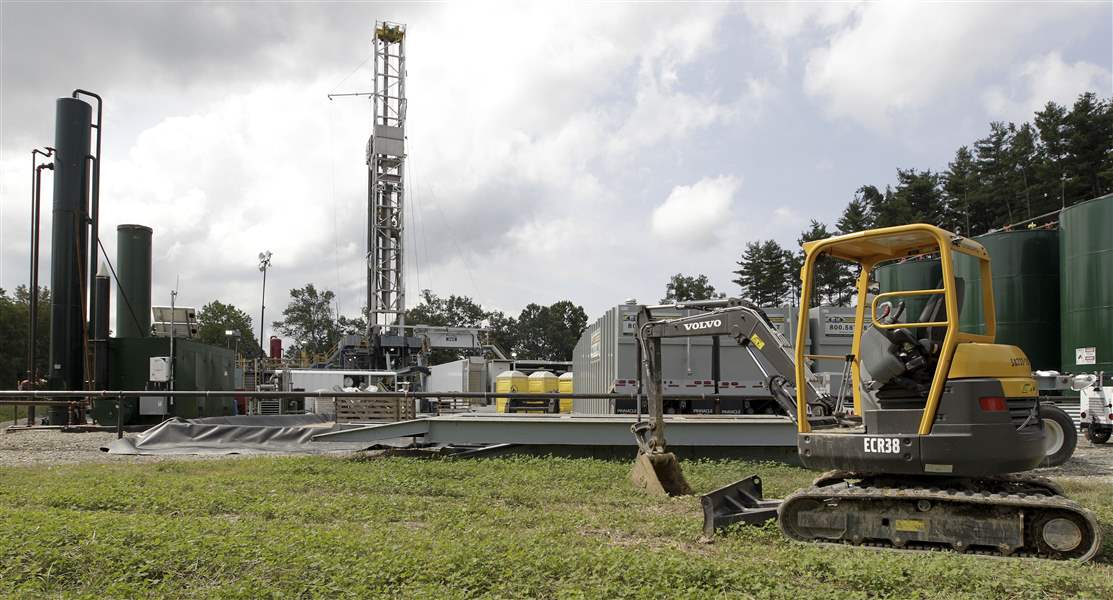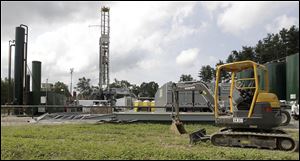
Oil and gas association, environmental group team up on capping idle, abandoned wells
2/4/2018
This Aug. 13, 2013, file photo shows a gas drilling rig at the Detweiler well in Salesville, Ohio.
ASSOCIATED PRESS
Ohio has more than 700 oil and gas wells that have never been plugged or were improperly plugged years ago, resulting in safety risks to children and environmental risks to groundwater and area streams.
Nearly a third of them are in northwest Ohio, with most of the other problem areas near Cleveland and southeast Ohio.

This Aug. 13, 2013, file photo shows a gas drilling rig at the Detweiler well in Salesville, Ohio.
Now, two groups often at odds with each other believe they have come up with a solution. Their biggest challenge appears to be convincing the Ohio Senate and Gov. John Kasich they aren’t being overly ambitious.
The Ohio Oil and Gas Association and the Ohio Environmental Council are solidly behind House Bill 225, which sailed through the Ohio House of Representatives by a 92-0 vote last month.
It would require 45 percent of a state fund used for oil and gas programs to be dedicated to capping idle and abandoned wells — an increase from the current level of 14 percent. The bill also calls for multiple other changes intended to streamline Ohio Department of Natural Resources operations and reporting requirements, all with the goal of plugging wells faster.
Fund revenue grew from $3.1 million in 2008 to $52 million in 2017, an upward spiral driven by taxes collected as the modern era of horizontal fracking took hold. The latest fracking technique has opened previously inaccessible Marcellus and Utica shale in eastern Ohio, bringing the state its biggest drilling frenzy since the 1800s.
“We’ve got a unique opportunity to eradicate all idle and orphan wells across the state of Ohio,” said Mike Chadsey, Ohio Oil and Gas Association spokesman.
Ohio was America’s leading oil-producing state from 1895 to 1903, preceding Texas.
John D. Rockefeller, the wealthiest man in the world in 1895, got his start in the Cleveland area with Standard Oil Co. in 1870. Ohio moved past its neighbor Pennsylvania, where Col. Edwin L. Drake drilled the world’s first commercially successful oil well, at Titusville, on Aug. 27, 1859.
Findlay especially was rich in both oil and natural gas reserves. Marathon Oil got its start in Findlay. Natural gas was so plentiful, it was flared off in downtown street lamps and torches at one time, as illustrated in an 1885 photo published by Harper’s Weekly magazine.

Wood and Hancock counties are northwest Ohio’s leaders of known wells that were never capped or were improperly closed, with 79 and 42, respectively, according to state records.
Most of the wells in question were drilled before Ohio adopted its first oil and gas regulations in the 1960s.
Many of those were drilled before World War I, Mr. Chadsey said.
Back then, landowners might have simply stuffed a cannonball or tree limbs into them, he said.
“If they were plugged at all, it wasn’t up to today’s standards,” Mr. Chadsey said, explaining that the goal is to fill them with concrete.
Melanie Houston, director of the OEC’s climate programs, said idle and orphan wells pose not only a safety risk to children but also can release methane, the most potent greenhouse gas known to contribute to Earth’s warming climate. They likewise pose fire hazards while impacting water quality.
“We’ve had a long history of supporting the abandoned well program of the Ohio DNR and asking for it to be robust,” she said.
She said there are “potentially thousands” of trouble spots, because many idle and orphan wells from years past were never mapped.
Those questioning whether the legislation is too ambitious include the Ohio Office of Management and Budget. Rick Simmers, chief of the Ohio DNR’s oil and gas division, has said the proposed leap up to 45 percent of the state fund for capping is “problematic.”
“Simply put, there is not enough time or manpower available to accomplish this spending mandate,” Mr. Simmers testified.
Ohio has plugged more than 2,000 idle and orphan wells across the state since it began its plugging program in 1977.
Contact Tom Henry at thenry@theblade.com, 419-724-6079, or via Twitter @ecowriterohio.